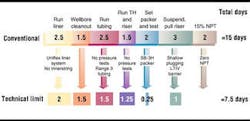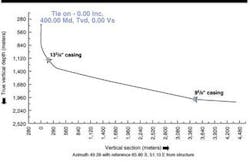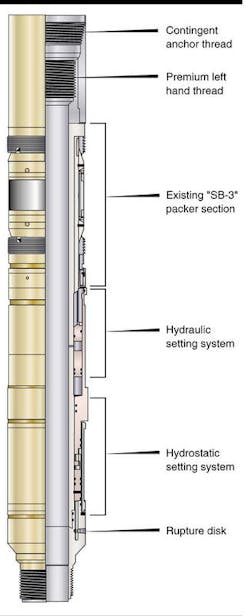COMPLETION TECHNOLOGY: 'Technical limits' approach helps reduce completions costs by 50%
The BP Schiehallion and Foinaven oilfields West of Shetland are benign shallow reservoirs, but lie in a harsh, 350 to 550-meter-deep subsea environ-ment. There have been up to three 4th generation semisubmersible rigs operating year-round on these fields since development drilling began in 1995. The two fields currently deliver about 250,000 b/d from two floating production, storage, and offloading vessels (FPSOs), 25 gas-lifted oil producers, 15 water injectors, and two gas disposal wells.
The reservoirs are benign, shallow turbidite tertiary sands, requiring high-angle wells to access reserves and improve production rates. Such profiles prevent wireline access to the packer/liner top. The sands are also weak, around 500-1,000 psi unconfined compressive strength, requiring sand control completions in all oil producers and in most water injectors.
From the start of planning development wells, there has been considerable focus on efficient drilling and completion, and on designs to last for the life of field. Opening new oilfields in a new province, the developments are high profile and a significant milestone for the UK industry.
Premium connections were used throughout the production casing and completions. Thirteen-percent chrome metallurgy was used for production wells, while water injectors used Inconel jewelry with lined or coated carbon steel tubulars. All wells used surface-controlled subsurface safety valves and permanent packers without an expansion joint. Also, the oil producers have conventional gas lift mandrels and permanent pressure/temperature gauges. Conventional dual-bore subsea trees were used - 5x2 for Foinaven, and 7x2 for Schiehallion. High drilling rig day rates provide a clear focus for avoiding workovers and interventions.
Avoiding re-work
With operating costs approaching US$250,000 per day per rig, the major part of well cost is rig time, so rig time savings represent very significant cost savings. High angle and extended reach wells are usually required for these fields, putting completion packers beyond wireline access.
The early completions used extensive coiled tubing operations to run and pull plugs as part of completion installation and often suffered from non-productive time (NPT) and waiting-on-weather time associated with the coiled tubing work. Completions could take up to 15 days, excluding the subsea tree installation, highlighting the potential savings of interventionless completion installations.
In 1999, following the experience on 25 West of Shetland wells with other interventionless systems, the SB-3H packer was used for the first time. The primary method of packer setting is by rupture disk against an atmospheric chamber. Also, there is an independent, secondary, hydraulic setting mechanism.
The new interventionless hydrostatic packer can reduce rig time to set the packer from as much as six days (working with coiled tubing on floating rigs in poor weather) to less than 30 minutes. On top of these immediate cost savings, eliminating intervention brings significant health and safety advantages. Development and application of this packer and changes in completion practices have combined to cut completion installation times by up to 50%.
Technical limits
'Technical Limits' is a zero-based approach, where the design starts from a clean sheet rather than a photocopy, and all aspects of completion design and procedures are challenged. The technical limits approach identified interventionless completion installation as a key requirement, where completion installation does not require intervention into the well with e-line, slickline, or coiled tubing. Interventions cost rig time, require people to handle equipment, and can result in NPT.
There are several methods of achieving interventionless installation. These include mechanically set packers, liner top completions, hydraulic-set packer completions with a seal assembly on the tailpipe, and remotely actuated packer systems.
For the deepwater West of Shetland completions, the remotely actuated packer was selected as the most appropriate interventionless completion option. This packer eliminates completion space-out. In deepwater, the process of spacing out the completion string between the fixed depths of the liner top and mudline wellhead represents more then 24 hours rig time.
Remotely actuated packers
The three categories of remotely actuated packers are hydro-mechanical devices, pressure pulse telemetry, and absolute well pressure activation.
The hydro-mechanical devices, run as part of the completion tailpipe, typically operate by pressure cycles down the tubing and provide the opportunity to test the completion tubing before setting the packer. When run in hole, the device has a ball or flapper obstruction in the tubing and a by-pass to self-fill the completion as it is run.
Once at depth, pressure cycles may be required to close the by-pass to allow tubing tests. Further pressure cycles set the completion packer via a short control line from the device to the packer. Additional pressure cycles down the tubing then function the tool to open the obstruction. Usually, these tools leave a full-open internal diameter. Uni-directional and bi-directional devices are available.
The uni-directional barrier devices are run in closed and self-fill across the sealing mechanism, allowing multiple tubing tests while running the completion. Applying a sequence of pressure cycles down the tubing then sets the packer.
The bi-directional tools are run in closed, but auto-fill through a separate device in the tubing which prevents tubing tests until this device is closed. The device provides remote setting of the packer, and the bi-directional barrier can also be used to provide a well suspension barrier.
Pressure pulse telemetry is similar to mud-pulse telemetry used in measurement/logging while drilling (MWD/LWD). This technique, available since 1996, allows running in-hole with the packer and tailpipe open-ended. Pressure pulses are transmitted down the fluid column in the tubing or annulus from a surface unit. An electronics module on the packer or downhole tool detects the pressure pulses, and when a pre-programmed pattern of pulses is detected, the packer actuates and sets. This type of tool does not allow interventionless tubing tests, but the pressure pulses avoid the requirements for a cemented liner or isolation from the lower completion.
Absolute well pressure activation is the simplest remote actuation system. These tools, also commonly known as 'hydrostatic' tools, were selected as the system of choice for the Schiehallion and Foinaven fields. The concept of actuating equipment using absolute well pressure is commonplace, particularly in drill stem testing (DST) and perforating equipment. Such tools hold atmospheric air pressure in a chamber as they are run to depth and use a rupture disc for actuation.
When the absolute pressure in the well exceeds the differential pressure rating of the rupture disc, the disc ruptures, allowing wellbore fluid into the tool. The pressure difference between wellbore pressure and the atmospheric chamber provides the driving force for setting or actuating the tool.
Hydrostatic packer
The use of an atmospheric chamber in permanent packers, developed as part of the company's Edge pressure-pulse telemetry actuated systems, is used in the SB-3H packer. Absolute well pressure activation in a completion packer is simple and reliable, but has one drawback - it requires the well to be unperforated or to have the lower completion hydraulically isolated.
In late 1998, BP defined the requirements for a remotely actuated permanent packer:
- Use a field-proven packer system to minimize lead-time and give assurance of packer performance.
- Use a hydrostatic-set system to remotely set the packer with the highest quality rupture disks available and a simple setting procedure requiring minimum rig time.
- Provide a fully independent hydraulic-setting mechanism, so that an option always exists to intervene, plug the tailpipe, and set the packer by conventional hydraulic differential between tubing and annulus.
- Perform a full suite of tests on the new packer to understand hydrostatic setting, mandrel movement, and packer performance.
- Develop a rigorous quality assurance manufacturing and packer management plan to give the highest possible level of reliability assurance.
From this starting point, the first SB-3H packer was successfully installed in spring of 1999, representing the culmination of several initiatives. Packer development had followed the logical route of adding the hydrostatic setting mechanism onto a proven SB-3 permanent packer chassis. Since the first SB-3H packer installation in April 1999, another 14 have been run without problems. The completion design has delivered a step change in the West of Shetlands completion installation performance, with the hydrostatic packer being a key component. The average completion time was cut by 50% between 1997 and 1999, and some high-angle completions have been installed without a subsea test tree.
Perhaps one of the more contentious changes introduced along with the hydrostatic-set packer was the elimination of all tubing pressure tests until after the permanent packer is set. Historically, completions were pressure tested during installation. It is still common to see fields where 2-3 pressure tests are done ahead of picking up the tubing hanger.
Each pressure test requires slickline runs with a standing valve or plug and prong to a tailpipe nipple. If the pressure test indicates a leak, diagnostics are then required to determine if the leaks are in the tubing string or in the wireline plug installed to test the tubing. In many cases, debris or pipe dope is blamed for wirelining problems and for difficulties in obtaining a leak-tight, deep-set plug.
Field statistics showed that there were very few examples of finding leaks in the tubing string by this method. Pressure testing operations could consume up to 30% of total completion installation time, with the accompanying NPT from the numerous interventions. In a study by Amoco on 60 North Sea completion installations during the 1990s, there was no evidence of any tubing string leaks on over 19,500 connections and 180 tubing pressure tests.
Today's quality assurance processes, the wide use of premium tubing threads, and the computerized torque-turn make-up has virtually eliminated the possibility of a leaking connection or hole in the tubing being identified in a 30-minute hydrostatic test. For West of Shetlands, specific measures were taken with offshore-dedicated thread inspectors and a specific focus on leak-risk items such as gas lift mandrels.
Technical limit challenge
Some of the practices outlined here may provide inspiration for similar technical limit challenges of established completion practices in other fields. Many of the drivers described here are derived from the deepwater subsea environment West of Shetlands. The application of hydrostatically set packers is limited to permanent or retrievable packer situations where the liner is unperforated or a suitable liner top barrier exists.
'Technical Limits' performance in completion installation requires new techniques and new tools. Interventionless tools may demand simplification of over-complicated designs. For example, a hydro-mechanical tailpipe device used in the early completions for tubing testing was removed in this project.
The well-established use of hydrostatic pressure in downhole tools was adopted for the first time in a permanent production packer, where the highest levels of performance assurance were demanded. The designs and procedures were challenged and changed, with equipment being installed only if essential.
The hydrostatically set packer may be applicable to a wide range of offshore and onshore fields, and can be particularly cost effective where it removes the need for coiled tubing interventions.S
Acknowledgment
Frank Radez of Baker Hughes updated and adapted this article from SPE-OTC 13288 presented at the 2001 Offshore Technology Conference, Houston, Texas, 30 April-3 May, 2001. Also, the author thanks BP and its West of Shetland co-venturers Amerada Hess, Murphy Oil, OMV (UK), Shell, and Statoil for permission to publish this article.
References
John N., Mason, P., King, J., Cameron, P., "Interventionless Hydrostatic Packer Experience in West of Shetland Completions," OTC 13288, presented at the 2001 Offshore Technology Conference, Houston, Texas, 30 April-3 May, 2001.
Leach, H., Herbert, N., Los, A., Smith, R.: "The Schiehallion Development", Petroleum Geology of Northwest Europe: Proceedings of the 5th Conference, 1999.



